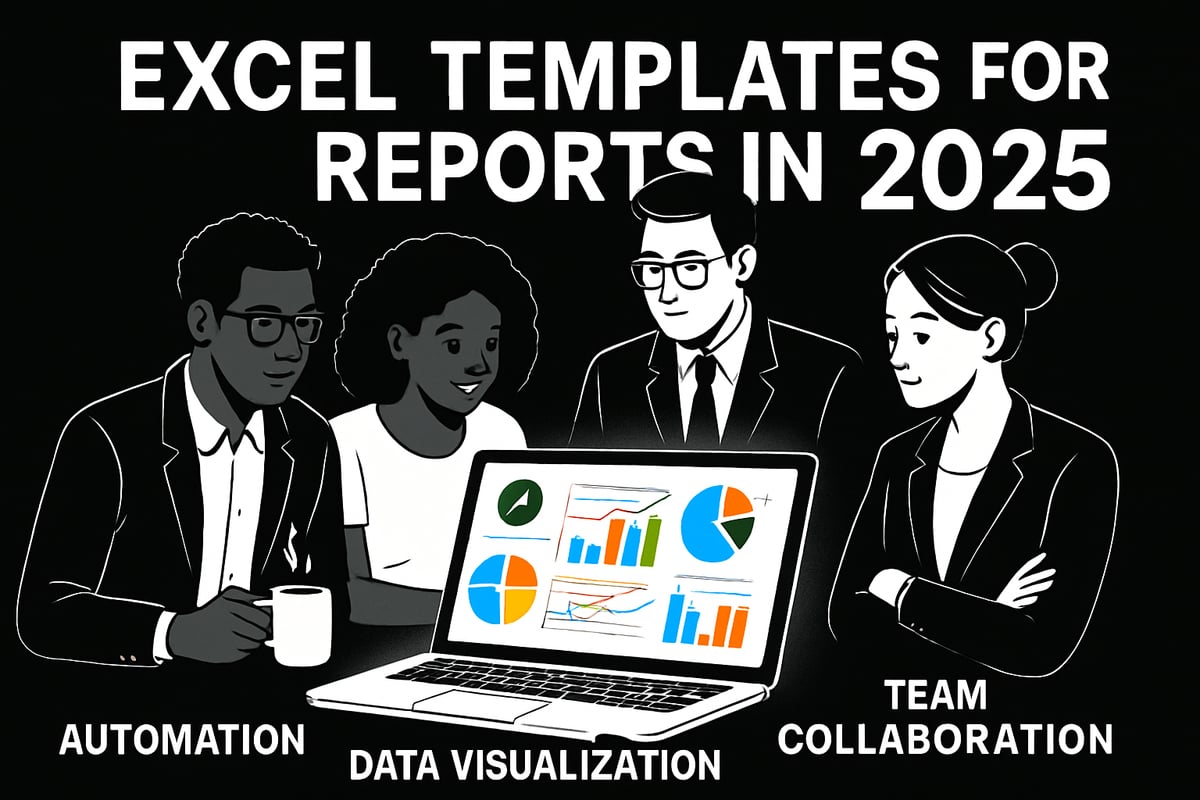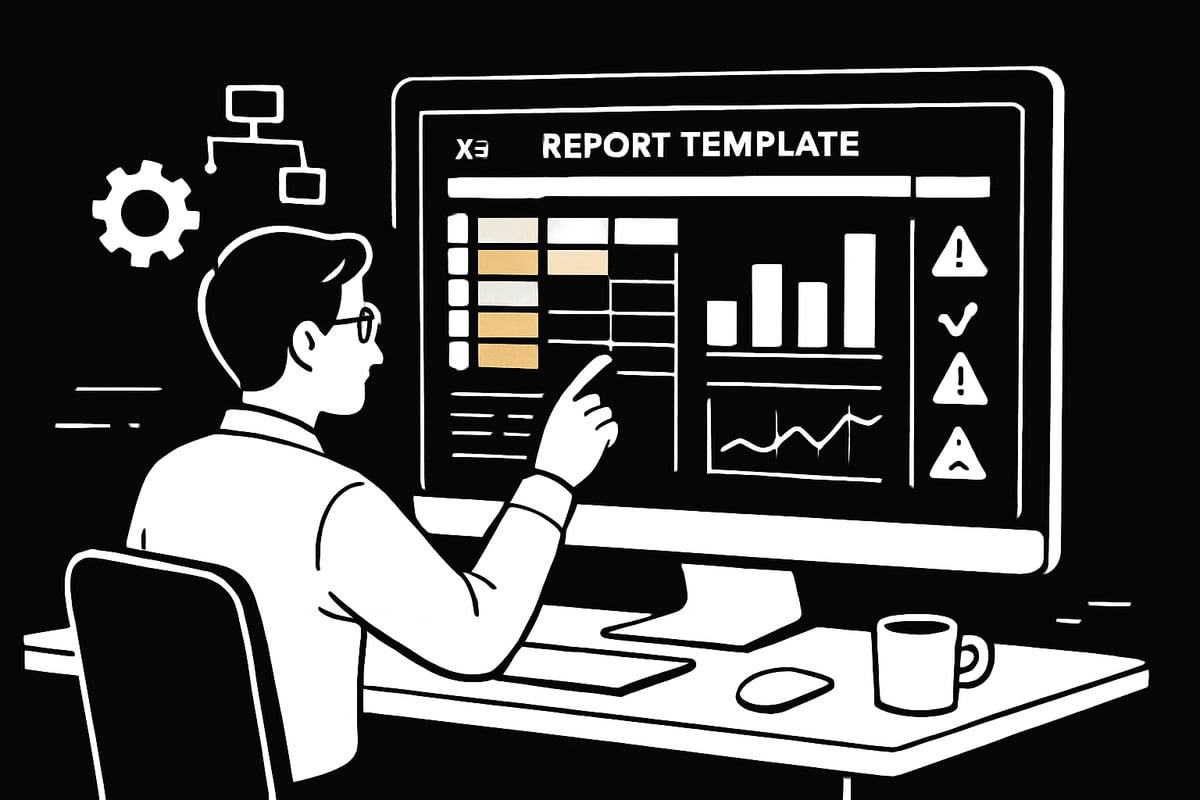In 2025, organizations depend on data more than ever, making clear and compelling reports crucial for success. Yet, many professionals still struggle with reporting challenges like tedious formatting, manual errors, and inconsistent insights.
The good news? Excel templates for reports are transforming how teams work by streamlining report creation, improving accuracy, and saving valuable time. This article reveals nine essential templates that will elevate your reporting in 2025, complete with actionable tips for each.
Why Excel Templates Are Crucial for Modern Reporting
In 2025, the volume and speed of business data are higher than ever. Decision-makers must act quickly, but without clarity, data can overwhelm rather than empower. This is where excel templates for reports become indispensable. They turn complex data into actionable insights, letting teams keep pace with the demands of a data-driven world.
One of the biggest advantages of excel templates for reports is standardization. When every team member uses the same layout, formulas, and structure, errors drop dramatically. Templates guide users through the reporting process, reducing the chance of accidental mistakes or inconsistencies. According to a Microsoft case study, organizations adopting standardized templates have seen up to a 30% reduction in report preparation time.
Automation is another key benefit. Excel templates for reports can automate repetitive calculations, data imports, and formatting. This frees up valuable hours previously spent on manual updates. Imagine not having to recalculate totals or reformat tables for every weekly meeting. Automation not only saves time but also helps ensure reports stay accurate, even as data changes.
Collaboration is also enhanced when teams use shared excel templates for reports. With consistent formats and built-in data validation, different departments can contribute data seamlessly. This consistency makes it easier to compile cross-functional reports, align on definitions, and ensure everyone is speaking the same language. Teams can work in parallel, improving efficiency and speeding up decision-making.
When choosing excel templates for reports, look for features that support modern business needs. Top templates now include automation tools, data visualization elements, and compatibility with other systems. Here’s a quick comparison of must-have features:
| Feature | Why It Matters |
|---|---|
| Automation | Saves time, reduces manual errors |
| Data Visualization | Simplifies complex insights |
| Compatibility | Enables integration with other tools |
Industries across the board benefit from these advanced templates. Finance teams use them for precise budgeting and forecasting. Marketing departments rely on them for campaign analytics. HR professionals streamline performance reviews, while project managers track milestones and risks. For those seeking inspiration or ready-made solutions, Excel Report Templates: Build Better Reports Faster offers a curated collection and insights into effective report design.
In summary, excel templates for reports are not just a convenience—they are essential for accuracy, speed, and collaboration in today’s business landscape. They empower organizations to make smarter decisions, faster, by turning raw data into reliable, actionable reports.

9 Essential Excel Templates for Reports in 2025
In 2025, organizations face mounting pressure to deliver timely, accurate insights. The right excel templates for reports can transform how businesses analyze and present data. Below, explore nine cutting-edge templates that are shaping the future of reporting, each designed to solve common challenges and unlock new levels of efficiency.

1. [Dynamic Dashboard Report Template]
Dynamic dashboards are at the heart of modern excel templates for reports. They offer real-time insights through interactive visuals and automated updates. Executives, analysts, and managers rely on these dashboards for at-a-glance performance monitoring.
Key features include automated data refresh, slicers for custom views, and built-in charts for KPIs. Imagine a monthly sales dashboard where you instantly filter by region or product. Visual storytelling and rapid data comprehension make these templates invaluable.
One standout advantage is seamless integration with Power Query, enabling connections to any data source. This flexibility means your dashboard evolves with business needs. According to Deloitte, 52% of organizations report higher productivity when using dashboard templates.
| Feature | Benefit |
|---|---|
| Automated Refresh | Always up-to-date data |
| Slicers & Filters | Personalized insights |
| KPI Tracking | Fast decision-making |
Want to learn more? Check out these Advanced Excel dashboard techniques to take your dashboards to the next level.
2. [Automated Financial Statement Template]
Financial reporting is crucial for all businesses. Automated templates redefine how excel templates for reports support accountants, CFOs, and business owners. These templates bundle pre-built income statements, balance sheets, and cash flow reports.
Built-in formulas and error checks reduce manual entry and increase accuracy. Data flows from transaction logs, auto-populating quarterly financials. Scenario analysis tools help forecast and model different outcomes with ease.
A unique edge is compliance support, ensuring reports meet regulatory standards. According to a PwC survey, organizations using these automated templates saw a 40% reduction in month-end closing time.
Benefits:
- Reduces errors and saves time.
- Ensures consistency across reports.
- Streamlines forecasting and planning.
3. [Project Status Report Template]
Project management thrives on clarity. With excel templates for reports like the Project Status Report Template, teams track milestones, deadlines, budgets, and risks in one place.
Features such as Gantt charts, progress bars, and automated alerts keep everyone aligned. Weekly project updates become simple, and stakeholders always know where things stand.
You can customize these templates for Agile, Waterfall, or hybrid methodologies. Standardized status reports increase transparency and boost project success rates. PMI data shows 70% of successful projects use such templates.
List of core features:
- Gantt chart visualization
- Automated overdue task alerts
- Customizable workflows
For even deeper insights, see how Excel for project management reports can further streamline your reporting process.
4. [Marketing Campaign Performance Template]
Marketing teams need excel templates for reports that bring all campaign data together. The Marketing Campaign Performance Template is built for this purpose, automating data pulls from sources like Google Analytics and Ads.
Pre-built charts display KPIs, ROI, and conversion rates across channels. Monthly reports become quick to generate and easy to interpret. Teams can spot trends and pivot campaigns without delay.
Integration with Power BI is a unique feature, enabling advanced analytics and deeper dives into campaign data. HubSpot benchmarks reveal a 45% faster campaign analysis using these templates.
Key advantages:
- Automated data aggregation
- Multi-channel performance tracking
- Supports rapid decision making
5. [HR Employee Performance Review Template]
Consistency is vital in HR evaluations. Excel templates for reports standardize performance reviews, making them fair and actionable. The HR Employee Performance Review Template automates scoring, compiles feedback, and tracks goals over time.
Managers and HR teams benefit from summary dashboards and competency mapping. Annual reviews include both self-assessment and manager input, ensuring balanced perspectives.
Succession planning is built in, helping organizations prepare for future leadership needs. SHRM data shows a 60% improvement in review completion rates with standardized templates.
Notable features:
- Automated scoring and dashboards
- Goal tracking and development plans
- Competency and succession mapping
6. [Sales Pipeline Tracker Template]
Sales success hinges on visibility. The Sales Pipeline Tracker Template is one of the most popular excel templates for reports among sales teams. Visualize sales stages, deal values, and win probabilities with ease.
Drag-and-drop tracking makes updating deals simple. Automated forecasts and real-time alerts ensure high-value opportunities get the attention they deserve. These templates are mobile-friendly and integrate with CRM exports.
A Salesforce report found a 35% increase in sales closure rates for teams using pipeline tracking templates.
Summary table:
| Feature | Value Provided |
|---|---|
| Real-time pipeline | Prioritizes key deals |
| Forecast automation | Accurate sales outlook |
| CRM integration | Seamless workflows |
7. [Annual Budget Planner Template]
Budgeting is more strategic with excel templates for reports like the Annual Budget Planner. Finance teams can plan, track, and adjust budgets by department or project.
Scenario modeling and variance analysis help anticipate challenges and optimize spending. Approval workflows and audit trails add accountability and transparency to the process.
Built-in features prevent overspending and improve forecasting accuracy. CFO.com notes a 50% reduction in budget overruns for companies adopting these templates.
Key components:
- Scenario modeling tools
- Real-time variance tracking
- Approval and audit trail management
8. [Customer Feedback & Survey Analysis Template]
Customer feedback shapes products and services. With excel templates for reports tailored for survey analysis, teams aggregate and analyze responses from multiple channels.
Automated sentiment analysis, trend charts, and NPS scoring highlight areas for improvement. Product and service teams use these insights for quarterly satisfaction reports.
These templates support imports from survey tools and create real-time dashboards for ongoing monitoring. Qualtrics found a 48% faster feedback analysis using advanced templates.
Features at a glance:
- Sentiment and trend analysis
- NPS and satisfaction scoring
- Multi-source data integration
9. [KPI Scorecard Template]
Tracking performance across business units is challenging. KPI Scorecard Templates are essential excel templates for reports, enabling organizations to visualize custom metrics and trends.
Color-coded alerts signal issues at a glance, while trend analysis supports strategic planning. Monthly operations scorecards with traffic-light indicators keep everyone focused on goals.
Export-ready formats make sharing results with boards and executives effortless. Gartner research shows a 55% improvement in KPI tracking accuracy when using these templates.
Highlights:
- Customizable KPI metrics
- Visual alerts and trend tracking
- Board presentation-ready exports
How to Choose the Right Excel Template for Your Reporting Needs
Selecting the best excel templates for reports starts with understanding your business goals and the types of insights you need to deliver. Every organization has unique reporting requirements, whether it's tracking sales growth, monitoring budgets, or analyzing project progress. Begin by mapping out your objectives and identifying the specific reports that will drive decision-making in 2025.
Consider the data sources you rely on most and the frequency with which reports are generated. Are you handling complex financial data, or do you need to visualize marketing trends quickly? By aligning your excel templates for reports with your core business questions, you ensure your templates provide actionable value rather than just pretty visuals.
Next, evaluate the features that matter most for your workflow. Look for automation capabilities, such as auto-refreshing data and built-in error checks, to minimize manual work. Customization is key—templates should adapt to your company's branding and reporting standards. Integration with other tools, like Power BI or Google Analytics, can further streamline your process. For a deeper dive into automation benefits, explore these Automated Excel spreadsheet solutions that highlight how modern templates can save time and reduce errors.
Scalability is another crucial factor. As your organization grows, your reporting needs will evolve. Choose excel templates for reports that are flexible enough to accommodate new data sources, additional users, and increased complexity. Prioritize templates that offer regular updates and support for the latest Excel features, ensuring your investment remains future-proof for 2025 and beyond.
Security and data privacy should never be overlooked. Ensure your excel templates for reports include permission controls and protect sensitive information with password encryption or restricted access. User-friendliness is equally important. According to Forrester, 68% of businesses cite ease of use as the top factor when choosing templates. Training and documentation can boost adoption rates, especially across departments with varying Excel skill levels.
Finally, match template types to your business needs. For example, a project manager may benefit from a Gantt chart template, while a CFO might rely on budget planners or financial dashboards. If you're searching for ready-made options, check out these Free Business Report Templates to compare styles and functions.
Here’s a quick table summarizing the top criteria:
| Selection Criteria | Why It Matters |
|---|---|
| Automation & Integration | Speeds up reporting, reduces manual errors |
| Customization | Fits your brand and reporting standards |
| Scalability | Adapts as your business and data needs grow |
| Security & Privacy | Protects sensitive information |
| User-Friendliness | Increases adoption and accuracy |
Choosing the right excel templates for reports is about balancing your current needs with future demands. By focusing on automation, scalability, usability, and security, you set your team up for reporting success in 2025.
Tips for Customizing and Maximizing Your Excel Templates
Customizing excel templates for reports can transform basic spreadsheets into powerful, tailored solutions. Start by reviewing your workflow to spot areas where template adjustments will save time and reduce errors. Even small tweaks can make a big difference in daily operations.
Step-by-Step Guide to Adapting Templates
Personalizing excel templates for reports starts with mapping out your reporting needs. Identify which data fields, calculations, and visualizations matter most for your team.
Next, duplicate the original template before making changes. This ensures you always have a master copy. Update headers, formulas, and chart sources to match your unique data structure.
Leveraging Built-In Excel Tools
Unlock the full potential of excel templates for reports by tapping into built-in features. Use Power Query to automate data imports and transformations.
Incorporate VBA scripts for repetitive actions like formatting or report generation. Apply conditional formatting to highlight trends or flag issues instantly. These tools help streamline complex reporting tasks.
Best Practices for Data Integrity and Version Control
Maintaining data integrity is crucial. Always validate formulas after customization to prevent reporting errors. Set up version control by saving new iterations with clear naming conventions.
Consider using cloud storage for real-time team collaboration and easy access. For more tips, explore 15 Essential Excel Report Templates for proven approaches.
Ongoing Improvements and Industry Examples
Regularly update your templates to reflect new business priorities or regulations. Collect feedback from users to spot improvement areas.
Different industries, from finance to HR, have seen success by tailoring templates to fit their reporting styles and compliance needs. With the right approach, your excel templates for reports will remain valuable and future-ready.





